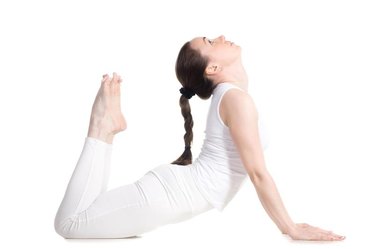
The muscles of your lower and middle back support your posture, help you lift heavy weights and protect your spine. Since lower back pain is one of the most prevalent health issues in the world, it's important to keep those muscles strong. The back extension works those spine-saving muscle groups, making it a valuable addition to many lower back pain prevention programs.
Variations of the Back Extension
Video of the Day
There are multiple versions of the back extension. You can use a machine that holds your legs and hips in place, called a back hyperextension machine, perform them on the ground or on a Swiss ball. One of the most studied versions of the back extension is the simple prone back extension. It doesn't require any equipment other than your body weight and a comfortable surface to lie on, making it the most accessible version of the exercise.
Video of the Day
Read More: Lower Back Extension Exercises
How To: Perform the prone back extension by lying on your stomach. Then, you simply arch your back and lift your chest, head and shoulders off of the ground without using your arms to help. This forces the muscles of your middle and lower back to do most of the work.
Back Muscles
Your back has multiple layers of muscles that are superficial, intermediate and deep. The muscles that extend the spine are part of the intermediate and deep layers.
Erector Spinae
The erector spinae is an intermediate muscle, and is one of the biggest muscles used in a back extension. It's actually broken up into three parts: the longissimus, iliocostalis and spinalis. The longissimus attaches to the spine, and begins in the neck and runs all the way down into your lower back. The iliocostalis begins at the bottom of your neck and runs all the way down to the bottom of your spine. The spinalis is the shortest of the three, and spans from the bottom of your neck to the top of your lower back.
Read More: Back Hyperextensions
Deep Muscles
Deep muscles used in the back extension exercise are the multifidus and semispinalis. The multifidus runs along the side of the spine, from the neck down to the bottom of the spine. The semispinalis covers the middle of the spine, from the bottom of the neck to the top of the lower back.

Neck Muscles
The back extension also works the muscles that extend the head and neck. The splenius and capitis muscle groups are responsible for lifting your head and neck up. They begin at the top of the spine and run up to the bottom of the skull, giving you control over your head and neck.
Hip and Leg Muscles
When you do a back extension, you work muscles in addition to the back extensors, including the glutes and hamstrings. In fact, according to a 2004 study published in Medicine & Science in Sports, the glutes and hamstrings can fatigue before the back muscles in a back extension, especially when weight is added to the exercise.
An Alternative Exercise
Prone leg extension, which means raising your legs while lying on your stomach, is similar to the back extension. The exercise also involves the back extensors, hamstrings, and glutes. According to a 2012 study published in Musculoskeletal Disorders, the back extensor muscles were only used 10 percent less during a leg extension than they were during a back extension, meaning these two movements are very similar in levels of back muscle activation.